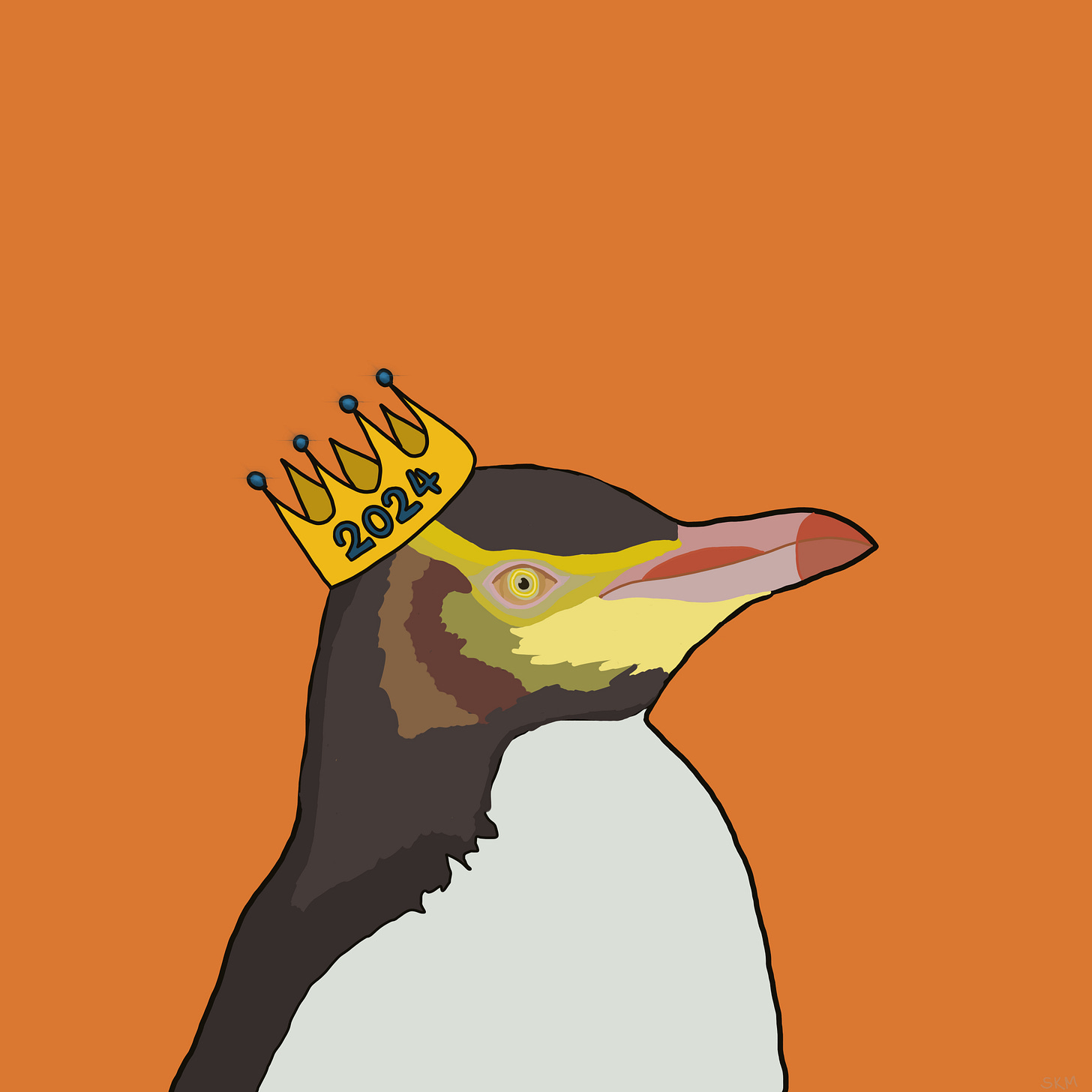Bird of the Year, Bird of my Heart
Why the "rare and smelly" penguin crowned Aotearoa New Zealand's 2024 Bird of the Year will always be a winner in my eyes
The winner of Aotearoa New Zealand’s Bird of the Year competition was announced last month and I was thrilled to see that the Hoiho/Yellow-Eyed Penguin took the crown. I’ve mentioned offhandedly that my mild phobia of dead things started when my grandmother made me help her pick dead penguins up off the beach near her house so she could put them in a freezer “for researchers.” I wanted to look back on the fonder memories I have of these “rare and smelly” birds (i.e., seeing them when they’re alive) as they bask in the glory of winning what appears to be a fair election with no meddling from award-winning comedians, and tell you a bit about them in the process.
Looking at the picture above, it probably took you less than two seconds to figure out the source of the yellow-eyed penguin’s English name: the distinctive yellow band around their eyes. But then, the British didn’t put much effort into some of the names they gave to places and things in Aotearoa, did they? (see: North Island and South Island).
However, to understand the 2024 Bird of the Year’s Māori name, you’d need to drop by the penguin social scene (but keep your distance, because humans getting too close stresses these anxious birds out). Hoiho means “noise shouter,” which is their strategy for attracting a mate. Coincidentally, this was also my strategy for attracting a mate when the people I talked to in crowded bars couldn’t decipher my kiwi accent. Just ask my partner, who later admitted that for the first few months we were seeing each other, he would just smile and nod whenever he couldn’t understand something I’d said. If I’d known, I would have gone back to the noise shouting.
As if these birds couldn’t be any more relatable, each year in autumn, they stay out of the ocean and sit in one place for about a month to lose their feathers and regrow them in a process called “the moult.” In other words, they use their annual leave to rot on a beach and avoid their responsibilities—sounds like a dream to me.
Hoiho are only found in Aotearoa and are among the rarest types of penguin in the world. There are two populations: one group lives on Stewart Island/Rakiura and the lower parts of the South Island (the northern population), and the other group lives on the Auckland Islands and Campbell Island, which are about 700km/450mi south of the South Island, en route to Antarctica (the southern population). The northern population decreased by 83% between 1996 and 2023, and experts worry that they could become extinct by 2060. The status of the southern population is unclear because they haven’t been thoroughly studied in over thirty years (although a survey of the group on Campbell Island is currently being carried out).
It breaks my heart to know that these birds, which mean so much to Aotearoa that one side of our five-dollar note is a hoiho on Campbell Island, might become extinct during my lifetime.1 It’s fitting that they’re on the note opposite Sir Edmund Hillary, who—alongside Tenzing Norgay—was part of the first pair to reach the summit of Mount Everest, because this species has an agonizingly large hill to climb to avoid extinction. Unfortunately, the path up the mountain is filled with obstacles like predators, pet dogs, starvation, blood parasites, and devastating bacterial diseases.
Holding a lifeless penguin in my hands while Nana urged me to put it in the plastic bag2 was the first time I correctly comprehended the finality of death as a child. This was a big step for me because my parents had to overwrite my understanding of death when I was a toddler after they buried a doppelgänger of the family cat, explained what happened, and then backtracked when the cat showed up at his own funeral. To me, hoiho are a reminder that life is wonderful and precious, but also achingly fragile. I know this because for almost a decade, I’ve taken the same route along the beach that I used to walk with Nana alone.
These penguins embody the memories I have with my Nana, of which there will be no new ones. Whenever I stayed with her, we would trek across sand and rocks to a spot with a view of the penguin colony, hopeful that we’d get there at just the right time to watch the hoiho from afar as they commuted down the rugged hillside toward the ocean to start their morning. The thought that the penguins are still going about their lives each day at the end of the beach where we spent so much time together is a source of comfort whenever I miss her.
Thankfully, hoiho are still here. These small and noisy and rare penguins will be my bird of the year, every year. Hopefully winning 2024 Bird of the Year will help put efforts to reverse the tide and pull them away from the edge of extinction back into the spotlight.
Check out the Yellow-Eyed Penguin Trust/Te Tautiaki Hoiho, Forest & Bird, or the Department of Conservation to learn more about the 2024 Bird of the Year, including conservation efforts.
For readers not familiar with NZ banknotes, each one (5, 10, 20, 50, and 100) has a native bird on one side and a famous person (all of whom are New Zealanders except for Queen Elizabeth II, who is on the 20-dollar note) on the other.
Think: “I’m tired of this, grandma!” “Well, that’s too damn bad!”





Love this story -- really strong mix of family and ecology. Thank you for sharing it with us. :)